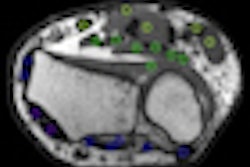CHICAGO - A steadily increasing number of radiologists use personal digital assistants (PDAs) as an extension of RIS/PACS for rapid preliminary diagnosis and emergency or specialist consultation. A new study from the Chelsea and Westminster Hospital in London pitted a new-generation smartphone against a PACS diagnostic workstation for diagnostic quality display of skeletal trauma radiographs, and the smartphone held its own.
"People want fast food, fast cars, and fast results, especially clinicians who want round-the-clock access to radiologists," Dr. Ne Siang Chew, a junior trainee in radiology, told attendees of his RSNA scientific presentation. "Traditional teleradiology is limiting because it presumes access to a workstation or laptop computer. Because smartphones are totally mobile, they have the potential to meet the demand for instant results."
But are they good enough to make accurate diagnoses?
Chew and colleagues compared the diagnostic interpretation accuracy of 40 appendicular skeletal trauma radiographs using a PACS workstation (Carestream Health, Rochester, NY) and a smartphone (iPhone, Apple, Cupertino, CA). Two consultant radiologists and two junior trainees in radiology individually read each set of images so that interobserver variability could be assessed.
The participants prospectively viewed images on either a diagnostic workstation or an iPhone; then, after a 14-day interval, they viewed the image on the other application. Responses were recorded on proformas and assessed against the diagnosis of experienced consultant radiologists interpreting only from a diagnostic workstation, Chew said. The reports of the consultant radiologists set the gold standard for the 320 proformas completed. Trial participants were blinded to all results.
"It is not feasible to consider transmission of a lossless compressed or even a low lossy compressed image, because neither Wi-Fi nor 2.5 G [EDGE] have adequate bandwidth. EDGE operates at 236.8 KB and Wi-Fi is two to three times faster," Chew stated. "We ended up using a 54x compression ratio transmitted over Wi-Fi."
"The images displayed on the iPhone were of good enough quality to make accurate diagnoses," Chew reported. "Our consultant radiologists provided an accurate diagnosis for 98% of the exams using the iPhone, making a misdiagnosis on only one exam. The trainees' accuracy rate was 93%. The entire set of images was interpreted accurately on the PACS workstation by the consultant radiologists, and the trainees' accuracy rate was 95%."
Interobserver variability using a kappa value between the workstation and the iPhone was 0.8, indicating almost perfect agreement. The error in reporting by the consultant radiologists was attributed to viewing a subtle abnormality on a display with a small field-of-view and a device that lacked image manipulation software.
This was the first prospective study to compare a new generation smartphone with a diagnostic workstation, according to Chew. He and his colleagues plan to conduct additional evaluations with a variety of smartphones. Chew said the next study will be of CT image brain hemorrhage.
By Cynthia Keen
AuntMinnie.com staff writer
December 4, 2008
Related Reading
PDAs may be suitable for viewing trauma head CT, January 25, 2008
Radiologists slow to adopt PDAs for practice, October 12, 2005
PDAs show promise for RIS/PACS portability, May 13, 2005
Copyright © 2008 AuntMinnie.com


















